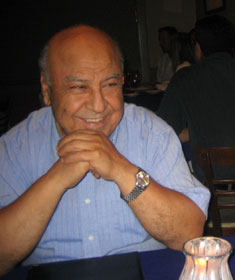April 27, 2008
www.aljazeerah.info
Archives
Mission & Name
Conflict Terminology
Editorials
Gaza Holocaust
Gulf War
Isdood
Islam
News
News Photos
Opinion Editorials
US Foreign Policy (Dr. El-Najjar's Articles)
|
|
Ahmed Hassan Joudah:
A Nakba Survivor from Isdood
Untold stories: Ahmad Joudah
IMEU, Apr 24, 2008
To interview Ahmad Joudah contact the IMEU at 510-451-2600 or
[email protected]
Nakba survivor Ahmad Joudah
 |
Before becoming a refugee himself, Ahmad Hassan Joudah
remembers going door to door in his village, recording the names of
newly-arrived Palestinians fleeing Zionist attacks in April 1948. "Many
from the big cities, such as Yaffa, and the surrounding villages near us
fled to our village," he explains. "I participated in tracking how many
new refugees arrived. It almost doubled the population. Each family
accommodated another family."
Born in 1934 in the village of Isdoud, located on the Mediterranean
between Gaza and Yaffa, Joudah was the son of a farmer. When he wasn't
excelling in school, he was tending to the family's cows, harvesting
wheat, or picking oranges, tomatoes and cucumbers.
In 1948, while attending high school in the nearby town of al-Majdal,
Joudah was notified that because of an increase in Zionist attacks
across Palestine, the school would be closed. "In late March, family
members came to take me home because the roads were not safe," he
explains. "There was a Jewish settlement between al-Majdal and Isdoud
that was dangerous because the Haganah, a Zionist militia, would sit at
the top of the water tank and snipe the Arabs who used the road. We were
lucky that day, they did not shoot."
Back in his village, Joudah helped keep track of refugees arriving from
elsewhere in Palestine. "During these two months, April and May, there
were lots of attacks by different Zionist militias. To the east of us
were three or four small villages. And they would attack them. I
witnessed many battles in during that time."
On May 29, the Egyptian army reached Isdoud to help defend the
Palestinians under attack, but their assistance was short-lived. In
October, the Egyptians withdrew and moved south to the borders of what
became the Gaza Strip. Fearing for their safety, most of the residents
of Isdoud left with them.
"When the Zionists massacred villages, such as Dair Yassin and Tantura,
the people became scared that what happened to those villages would
happen to them. Only about 300 people stayed behind, among them my
father. 'I am an old man,' he said. 'I'm not going to be a refugee.' A
few days later, the Zionists came to the village. Those between 17 and
40 they took as prisoners of war. The older people – including my father
– they put in a truck and dumped them in Gaza. They did not want the
people, they wanted the land," says Joudah.
After studying in Cairo and teaching in Saudi Arabia, Joudah obtained a
visa to enter the United States. There he earned a MA at the University
of Texas and a PhD at the University of Michigan. Joudah then taught at
universities in Libya and Saudi Arabia before coming back to the U.S. to
teach Arabic at Fort Campbell in Tennessee. He and his wife are now
retired and have five children.
Joudah feels it's important for Americans to understand what happened
during the Nakba. "In Palestine, the whole country was taken. That's
what Americans should understand," he says. "It's not only an economic
problem. It's not only a refugee problem. It's a problem of national and
cultural existence. The Nakba was intended to uproot and completely
demolish Palestinian nationhood. We feel that the U.S. has the power to
pressure Israel to concede the rights of the Palestinians. U.S.
interests can be served better through peaceful coexistence and friendly
relations rather than force."
***
The "Nakba" ("catastrophe" in Arabic) refers to the destruction of
Palestinian society in 1948 and the exile of more than 700,000
Palestinians from their homes and homeland. It is estimated that more
than 50 percent were driven out under direct military assault by Israeli
troops. Others fled in panic as news spread of massacres in Palestinian
villages like Dair Yassin and Tantura. Nearly half the Palestinian
refugees had fled by May 14, 1948, when Israel declared its independence
and the Arab states entered the fray.
Israel depopulated more than 450 Palestinian towns and villages,
destroying most while resettling the remainder with new Jewish
immigrants without regard to Palestinian rights and desires to return to
their homes. Israel still refuses to allow Palestinian refugees to
return to their homes and to pay them compensation, as required by
international law.
Today, there are more than 4 million registered Palestinian refugees
worldwide. The Nakba is a root cause of the ongoing conflict between
Israel and the Palestinians. Israel's denial of its expulsion of the
Palestinians and seizure of their homes and properties for Jewish use
continues to inflict pain and to generate resistance among Palestinians
today.
Read more untold
stories.
http://imeu.net/news/article008536.shtml
|
|
|
|
||
|
||||||


